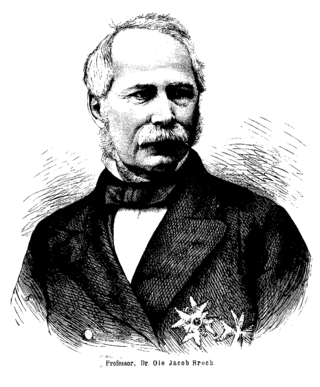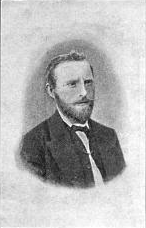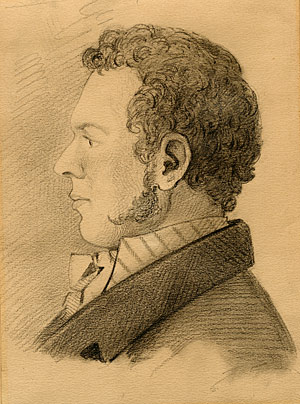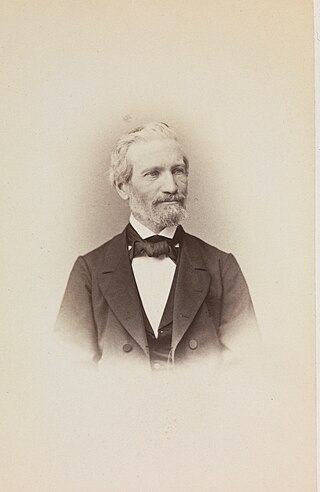Jens Peter Broch (November 6, 1819 – March 15, 1886) was a Norwegian orientalist and linguist that specialized in Semitic languages. [1] [2]
Jens Peter Broch (November 6, 1819 – March 15, 1886) was a Norwegian orientalist and linguist that specialized in Semitic languages. [1] [2]
Broch was born in Kristiansand. [1] He was the son of Johan Jørgen Broch (1791–1860), [1] a lieutenant colonel, a war commissioner, and parliamentarian, and Jensine Laurentze Bentzen (1790–1877). [2] His brother Ole Jacob Broch (1818–1889) was a mathematician at the university in Oslo, and they built their own homes in the neighborhood known as "Professor Town" (Norwegian : Professorbyen); Jens' house was named Fridarheim and Ole's Fagerheim. Jens married Louise Joachime Müller (1827–1913) in 1847; she was the daughter of Captain Otto Fredrik Müller (1782–1854) and Vilhelmine Hedevig Bech (1796–1880). They had no children, but a foster daughter Hedvig Bie (born Solberg), who was his wife's sister's daughter. [3]
Together with his brother Ole, Jens attended the Kristiansand Cathedral School for three years before the family moved to Christiania (now Oslo) in 1833. There they attended the private Headmaster Møller Institute (Norwegian : Overlærer Møllers institut), which Ulrik Wilhelm Møller (1791–1853) had founded in 1822. Jens studied there until he received his candidatus theologiæ degree in 1843, and then he became a teacher at the Nissen Latin and Secondary School (Norwegian : Nissens latin- og realskole), which his brother Ole had also just started teaching at. In 1845 he became a research fellow at the Royal Frederik University (now the University of Oslo), and was its second teacher in oriental studies and oriental languages, especially Arabic. He studied abroad and was hosted, among others, by Heinrich Leberecht Fleischer (1801–1888) in Leipzig, the same place where the prominent theologian Carl Paul Caspari (1814–1892) stayed from 1834 to 1838 and received his doctorate in 1842. It was the experience of Broch and Caspari in Leipzig that later inspired the theologian Elias Blix (1836–1902) to stay in the city from 1871 to 1872. [4] Broch also had a long stay abroad from 1853 to 1855. In 1859 he published the first Arabic text in Norway and he translated many poems from Arabic. [1] [2] He was elected to the newly established Christiania Science Society (now the Norwegian Academy of Science and Letters) in 1859, and to the Royal Norwegian Society of Sciences and Letters in 1877. He became an associate lecturer in 1865 and a full professor in 1876. His main work is a very careful edition of Al-Zamakhshari's grammatical work Al-Mufassal (1879). [5]

Peter Andreas Blix was a Norwegian architect and engineer best known for designing railway stations and villas in Swiss chalet style. He was also occupied with the conservation of Norwegian stave churches and the construction of canals in 19th century Norway.

Elias Blix was a Norwegian professor, theologian, hymn writer, and a politician for the Liberal Party. Blix wrote numerous hymns and was largely responsible for translating the New Testament into the Norwegian language.

Ole Jacob Broch was a Norwegian mathematician, physicist, economist and government minister.

Carl Paul Caspari was a Norwegian neo-Lutheran theologian and academic. He was a Professor of Old Testament Theology at the University of Oslo. He wrote several books and is best known for his interpretations and translation of the Old Testament.

Steinar Schjøtt was a Norwegian educator, philologist and lexicographer.

Johannes Henrik Nissen was a Norwegian architect.

Olaf Wilhelm Isaachsen was a Norwegian landscape and genre painter.

Bernt Michael Holmboe was a Norwegian mathematician. He was home-tutored from an early age, and was not enrolled in school until 1810. Following a short period at the Royal Frederick University, which included a stint as assistant to Christopher Hansteen, Holmboe was hired as a mathematics teacher at the Christiania Cathedral School in 1818, where he met the future renowned mathematician Niels Henrik Abel. Holmboe's lasting impact on mathematics worldwide has been said to be his tutoring of Abel, both in school and privately. The two became friends and remained so until Abel's early death. Holmboe moved to the Royal Frederick University in 1826, where he worked until his own death in 1850.
Events in the year 1848 in Norway.

Johan Christian Heuch or J. C. Heuch was a Norwegian bishop in the Church of Norway and politician for the Conservative Party.
Jens Peter Gløersen Debes was a Norwegian judge and politician.

Johannes Wilhelm Christian Dietrichson was a Norwegian Lutheran minister who played an important role in the initial establishment of the Synod of the Norwegian Evangelical Lutheran Church in America, which eventually became the Evangelical Lutheran Synod.

Ole Hartvig Nissen was a Norwegian philologist and educator. He founded Nissen's Girls' School in Christiania in 1849. In 1865 he became director-general in the Ministry of Education, while remaining one of three joint headmasters of Nissen's Girls' School until 1872. In 1873 he was appointed to the prestigious position as rector of Oslo Cathedral School.

Gudmund Stenersen was a Norwegian painter and illustrator.

Emil Theodor Schreiner was a Norwegian philologist and educator.

Fredrik Glad Balchen was a Norwegian teacher of the deaf.
Anton Wilhelm Brøgger was a Norwegian book printer.

Cathrinus Dorotheus Olivius Bang was a Norwegian literary historian and professor of Scandinavian literature at the University of Christiania.
Ole Hartvig Nissen Johannson, MBE was a Norwegian businessperson.

Jens Frølich Tandberg was the bishop of Oslo from 1912 to 1922.